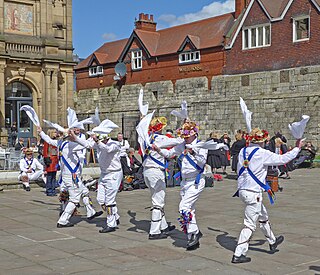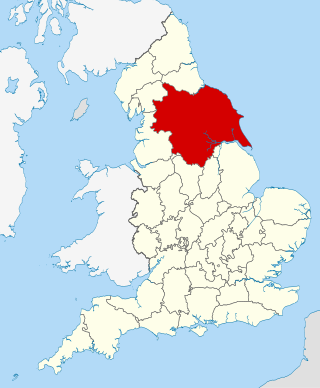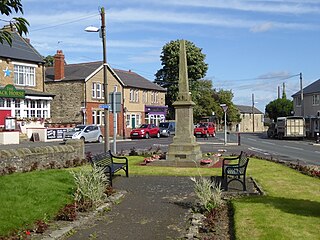
Morris dancing is a form of English folk dance. It is based on rhythmic stepping and the execution of choreographed figures by a group of dancers in costume, usually wearing bell pads on their shins and/or shoes. A band or single musician, also costumed, will accompany them. Sticks, swords, handkerchiefs, and a variety of other implements may be wielded by the dancers.

North East England is one of nine official regions of England at the first level of ITL for statistical purposes. The region has three current administrative levels below the region level in the region: combined authority, unitary authority or metropolitan borough, and civil parishes. They are also multiple divisions without administrative functions; ceremonial county, emergency services, built-up areas and historic county. The largest settlements in the region are Newcastle upon Tyne, Middlesbrough, Sunderland, Gateshead, Darlington, Hartlepool and Durham.
Pitmatic is a group of traditional Northern English dialects spoken in rural areas of the Northumberland and Durham Coalfield in England.

Tyne and Wear is a ceremonial county in North East England. It borders Northumberland to the north and County Durham to the south, and the largest settlement is the city of Newcastle upon Tyne.

Tyneside is a built-up area across the banks of the River Tyne in Northern England. Residents of the area are commonly referred to as Geordies. The whole area is surrounded by the North East Green Belt.

The Long Sword dance is a hilt-and-point sword dance recorded mainly in Yorkshire, England. The dances are usually performed around Christmas time and were believed to derive from a rite performed to enable a fruitful harvest.
Tommy and Betty are two roles in rapper sword dance that represent the father and mother of the dancers. The Tommy and Betty often introduce the dance to the audience and seek to engage the audience. As with so many traditional dances in England and Europe, these characters are integral to the tradition, and their role was documented in all of the earliest published descriptions of the Northumbrian dance – descriptions which pre-date the introduction of the flexible rapper sword which so fundamentally changed the dance.
Here Northumbria is defined as Northumberland, the northernmost county of England, and County Durham. According to 'World Music: The Rough Guide', "nowhere is the English living tradition more in evidence than the border lands of Northumbria, the one part of England to rival the counties of the west of Ireland for a rich unbroken tradition. The region is particularly noted for its tradition of border ballads, the Northumbrian smallpipes and also a strong fiddle tradition in the region that was already well established in the 1690s. Northumbrian music is characterised by considerable influence from other regions, particularly southern Scotland and other parts of the north of England, as well as Irish immigrants.
"Blaydon Races" is a Geordie folk song of 1862, with lyrics by George Ridley written in a style deriving from music hall. It celebrates the horse races held at Blaydon in North East England that year, although mostly composed in advance of the event. The words were inspired by the American ballad "On the Road to Brighton", to the tune of which they are set. The song has become a local anthem, and is frequently sung by supporters of Newcastle United Football Club, Newcastle Falcons rugby club, and Durham County Cricket Club.
The Dancing England Rapper Tournament (DERT) is a continuation of the most significant rapper sword dance competitions that were held in Newcastle upon Tyne, England, the centre of the coalfields where the dance originated. The modern annual weekend event, held at different venues in the UK, brings together rapper teams and sword dancers from around the country and occasionally abroad.

Clog dancing is a form of step dance characterised by the wearing of inflexible, wooden soled clogs. Clog dancing developed into differing intricate forms both in Wales and also in the North of England. Welsh clog dancing mainly originates from various slate mines where workers would compete against each other during work breaks. Northern English traditional clog dancing originates from Lancashire, Yorkshire, County Durham, Northumberland and the Lake District.

Seghill is a large village and former civil parish, now in the parish of Seaton Valley, located on the Northumberland border which is the county boundary between Northumberland and Tyne and Wear. Seghill is situated between the villages of Seaton Delaval and Annitsford, about 8 miles (13 km) north of Newcastle upon Tyne.

Shiremoor is a village in Tyne and Wear, Northern England. It is in the Metropolitan Borough of North Tyneside and formerly governed under Northumberland. In the 2011 census, it was included in the Tynemouth area of Tyneside. It is near the North East Green Belt, which surrounds Tyneside, Wearside and Durham. It is located around 3+1⁄2 miles from Whitley Bay.

Greenside is a village in the extreme west of the Metropolitan County of Tyne and Wear, England. Once an independent village in County Durham, it became incorporated into Tyne and Wear in 1974 and then the Metropolitan Borough of Gateshead in 1986.
The Northumberland Football Association is a governing body in the historic county of Northumberland, England. The association was formed in 1883. It is responsible for the governance and development of football at all levels in the county.
Thomas Harrison Hair was a British artist most famous for depictions of industrial scenes in north-eastern England in the first half of the nineteenth century.
Colin Ross was an English folk musician who played fiddle and Northumbrian smallpipes. He was a noted maker of Northumbrian smallpipes, border pipes and Scottish smallpipes, and one of the inventors of the modern Scottish smallpipes.
Robert Wilson (1829?–1881) was a British physician. From Castle Eden, County Durham, he graduated M.D. from the University of Glasgow in 1848. He practiced in Alnwick, Northumberland, and died aged 52.

The North East Combined Authority (NECA), officially the Durham, Gateshead, South Tyneside and Sunderland Combined Authority, is one of three combined authorities in North East England. It was created in 2014, and currently consists of the City of Sunderland; Metropolitan Borough of Gateshead, South Tyneside; and Durham County local authorities.
Dancing England was a series of showcase traditional dance concerts held at the Derby Assembly Rooms from 1979 to 1987. They were devised and curated by Phil Heaton and John Shaw, members of the Black Cap Sword Dancers, and two very notable characters on the Nottingham and Derby folk and dance scene of the 1970s. Dancing England was set up to showcase the best of traditional dance in the UK, along with unique and/or interesting folk customs to celebrate the UK's wide cultural heritage.











